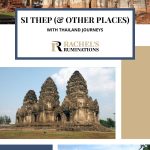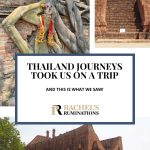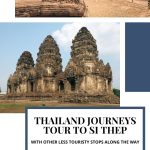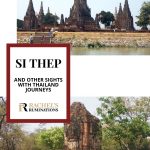A Si Thep tour with Thailand Journeys
Thailand added a new UNESCO site to its collection in October 2023: Si Thep, the remains of a town and several other monuments dating to the Dvaravati Empire in the 6th-10th centuries. Being the history geek that I am, I was eager to visit it on my recent trip to Thailand.
Si Thep, in central Thailand, is not at all on the tourist map as of yet, despite the popularity of Thailand as a destination. Fortunately, Thailand Journeys, a tour company based in Bangkok, has developed a new itinerary around a visit to Si Thep, and they were kind enough to offer to include my husband and me. This is the same company that took us on their Thai-Burma Railway day trip.
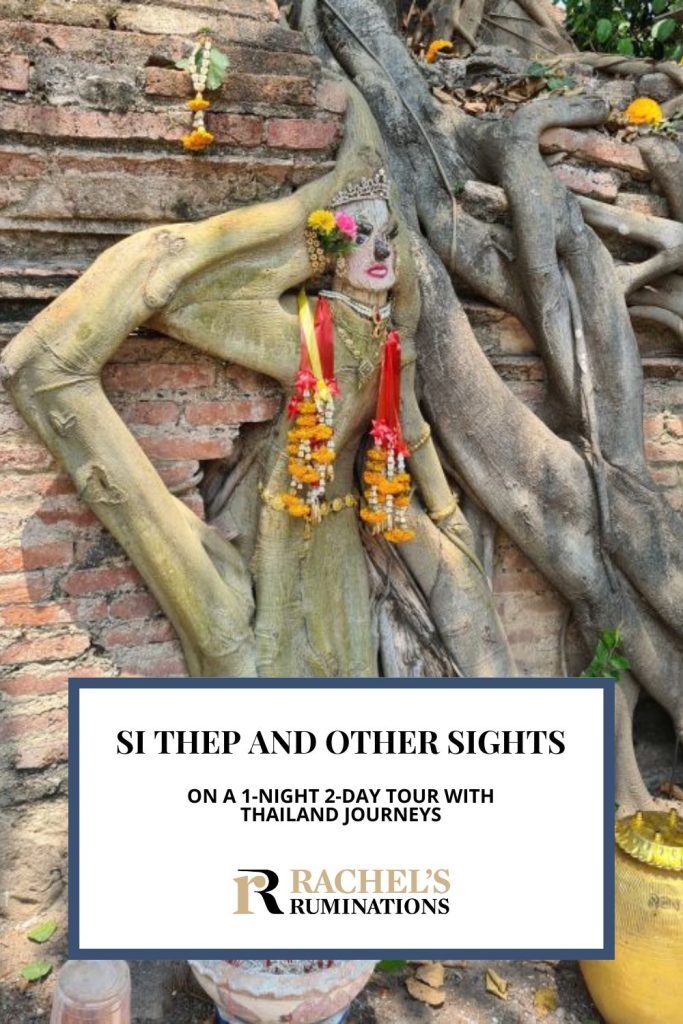
Disclosure: This is a sponsored post. Thailand Journeys provided this trip to us for free. Nevertheless, they have no influence over what I write, and I have tried to be as unbiased as possible.
Another disclosure: This article contains affiliate links. If you make a purchase through an affiliate link, I will receive a small commission. This will not affect your price.
They haven’t started even offering the tour yet, as of this writing. The tour I took was essentially a Thailand Journeys team outing, and we were invited along. The idea was to make sure their employees were familiar with the tour so that they’d have a clear idea what they were promoting. That meant that we did not have a regular guide. Instead, the owner, nicknamed Yoo, led the tour. It also meant being part of a very happy group of employees for two days.
Day 1
From our pick-up at our hotel, we joined the group in a van with comfortable seats and a driver. Our first stop was Ayutthaya. This is also a UNESCO site, and both my husband and I had already seen it. I feared it might be repetitive, but I figured I could at least get some better pictures of it.
It didn’t turn out that way. The intention here, I think, is that this is a tour for people who’ve already seen the most commonly-visited sites like Ayutthaya: people like me.
Book your accommodations in Thailand through Expedia, Booking.com, VRBO, or Hotels.com.
Na Phra Men temple in Ayutthaya
In Ayutthaya, we first went to Na Phra Men temple. This is an active Buddhist temple. Yoo guessed it as 14th century, but it’s not exactly known how old it is. One website I found dates it to 1503. Because it’s not on the “island” where most of the Ayutthaya ruins stand, it wasn’t damaged when Burmese troops burned Ayutthaya in 1767. So it’s old and it’s a part of the Ayutthaya Historical Park, but tourists do not often visit.

This temple is unusual because of the Buddha statue inside. While it sits in a typical pose, called Subduing Mara, it is not a typical Buddha. It is dressed in the style of a king, complete with crown. The story I was told is about a new king, Prasat Thong, who gained power in the 17th century by murdering not one but two heirs to the throne of the Siamese Ayutthaya Kingdom. He then started a new dynasty. He wanted to strengthen the association between himself and Buddha to lend himself some authority as king. Making the Buddha he commissioned look like a king implied that he himself was, in a way, a god-king.
Inside the temple, the group offered a prayer or blessing to the temple, Yoo explaining it as we went. First we knelt with the whole team in front of an orange-robed monk. He intoned prayers while the team responded in unison. The monk spoke in Sanskrit, while responses were in Thai, I think. Together, they bought a gift for the temple – a large piece of cloth for the Buddha statue and some flowers – and placed it at the foot of the Buddha statue.

Next, standing to the side of the Buddha statue, the temple caretaker took hold of a rope attached to the Buddha. We all took hold of it, connecting us to the Buddha, while the group intoned another prayer. Then, one by one, the caretaker tied a piece of yarn around our wrists. Yoo told us that this ritual would serve to bring us good fortune for the rest of the trip.
Boat trip around the “island” of Ayutthaya
Our next stop was a restaurant next to one of the three rivers that surround the island of Ayutthaya. Behind it, we boarded a small wooden motor-driven boat. Made of some sort of hardwood and highly polished, it had an open deck with a roof for shade and benches around its edge. A table had been set down the middle.
We set off down the river, cruising past all sorts of structures, among them the lovely 19th-century St. Joseph’s Catholic church, a couple of mosques, and lots of residences ranging from quite opulent to really basic. Some of them stood partially on stilts over the water. As we went, we enjoyed a very tasty lunch in the light breeze that the boat’s movement created. The food was mostly classic Thai dishes and was beautifully presented.
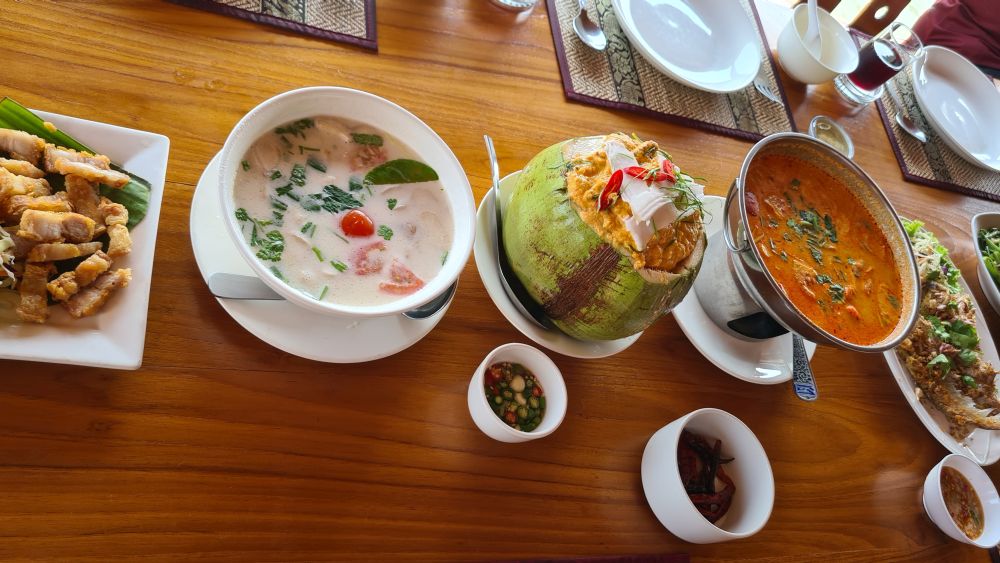
We couldn’t go clear around the “island” because there’s a bridge along the way that’s too low. But we went as far as one of the ancient Ayutthaya temple ruins, Wat Chai Wattanaran, which dates to the 17th century. It was built in the Khmer style under orders of that same emperor, Prasat Thong. Albert and I had both visited it before on land, but it looked very different from the river. On land it’s hard to see how the elements relate to each other, but on the river you can see the whole collection of structures.

Yoo told me that when they do the tours, if you book with a group together, he’ll rent the boat with lunch just for you. If you book for just a person or two, he may book you on a publicly-available version of the same thing, so you’ll do the boat trip with other tourists.
Kudi Dao temple
We returned to the pier where we had started and piled back into the van, which took us to Wat Kudi Dao not far away. Tourists rarely visit this 18th-century Ayutthaya temple. Yoo told us a story of a woman who may or may not have been killed on purpose and buried on the site to bring it good luck. The woman is portrayed as a figure made from tree roots growing on this temple, and people make offerings to her.
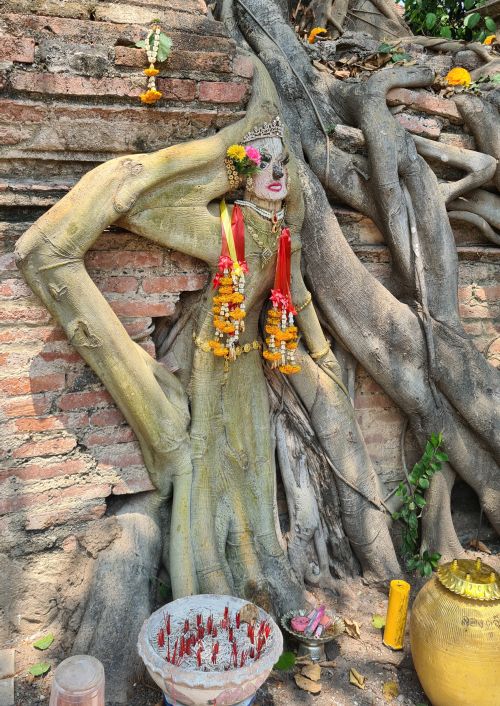
Part of the ancient Ayutthaya UNESCO site, Wat Kudi Dao was a Buddhist temple in the late Ayutthaya style. It was abandoned after the 1767 sacking by the Burmese. There are two large sermon halls that are largely intact and look remarkably like churches with their arched windows.
There’s also a large chedi or stupa in the middle – originally a bell-shaped spire on a square platform. The enormous spire has fallen. It sits on its side next to the platform, a sight that is somehow very dramatic.
Yoo was indeed correct. While Ayutthaya’s better-known temple complexes attract lots of visitors and tour groups, this one was practically empty apart from us and a handful of Thai visitors. Neither of us, on our separate trips to Ayutthaya, had seen this compound. It’s also, unlike the more visited areas, free to enter.
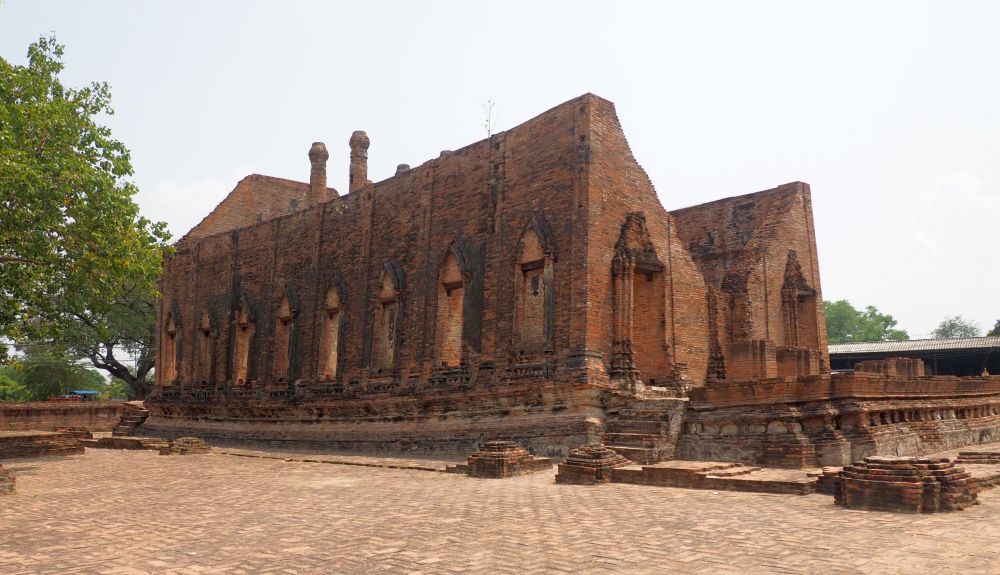
Monkey temple in Lopburi – Phra Prang Sam Yot
About an hour in the van later, we arrived at our next destination, in a city called Lopburi. As we approached Phra Prang Sam Yot temple, we noticed something odd about the streets of the city. There were fewer than usual street vendors, and there were monkeys! They were walking along the sidewalk here and there like a scene from a post-apocalyptic dystopia.
Once surrounded by forest, now in the middle of a city, Phra Prang Sam Yot is known as the Monkey Temple because lots of macaque monkeys live around it. At the entrance gate to this little temple, you pay your fee, but then you also get a stick to carry with you (and to return at the exit) just to keep the monkeys from harassing you, stealing your bag, etc. We were warned not to take any food or drink out of the van and to be careful with our belongings, especially anything shiny.
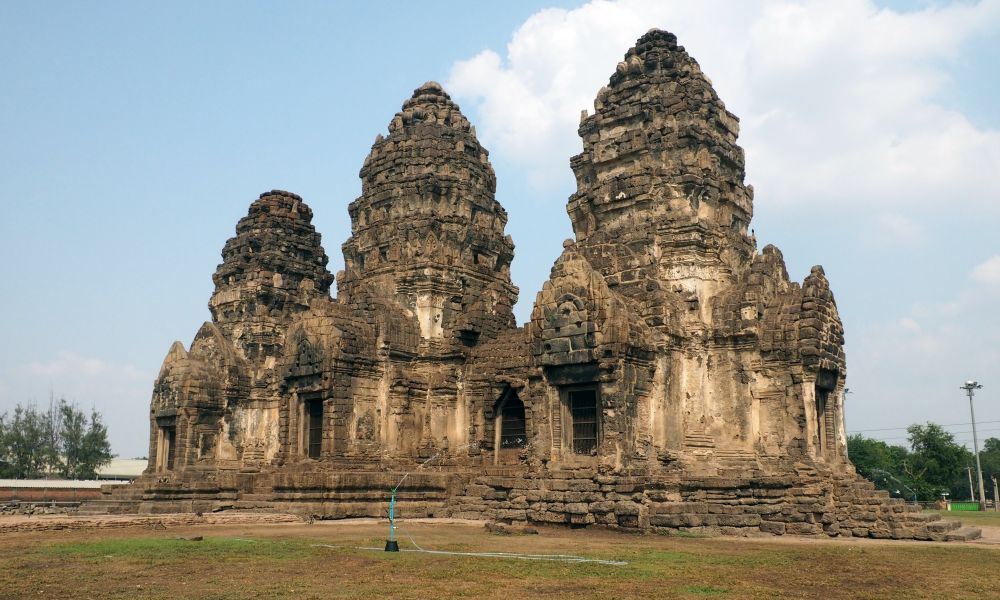
This is a Khmer period temple from the 13th century, built to show the Khmer Empire’s importance after it conquered the city. Originally a Hindu temple, it became Buddhist later on. Its central tower is dedicated to Buddha and the other two to Avalokitesvara, associated with compassion and wisdom or knowledge.
Apparently the location where the temple stands was once heavily forested and monkeys, of course, lived there. The local people didn’t mind because they considered them to be representations of the Hindu god Hanuman. As the forest dwindled, the locals fed the monkeys.
Nowadays, though, they’re a nuisance. They’ve become bolder, invading homes, eating from trash cans, and generally destroying property. The pandemic exacerbated the situation because where before many tourists fed them, during the lockdown only some locals gave them food. Since then, the tourist numbers haven’t come back up. There are even monkey gangs causing havoc when they fight over food.
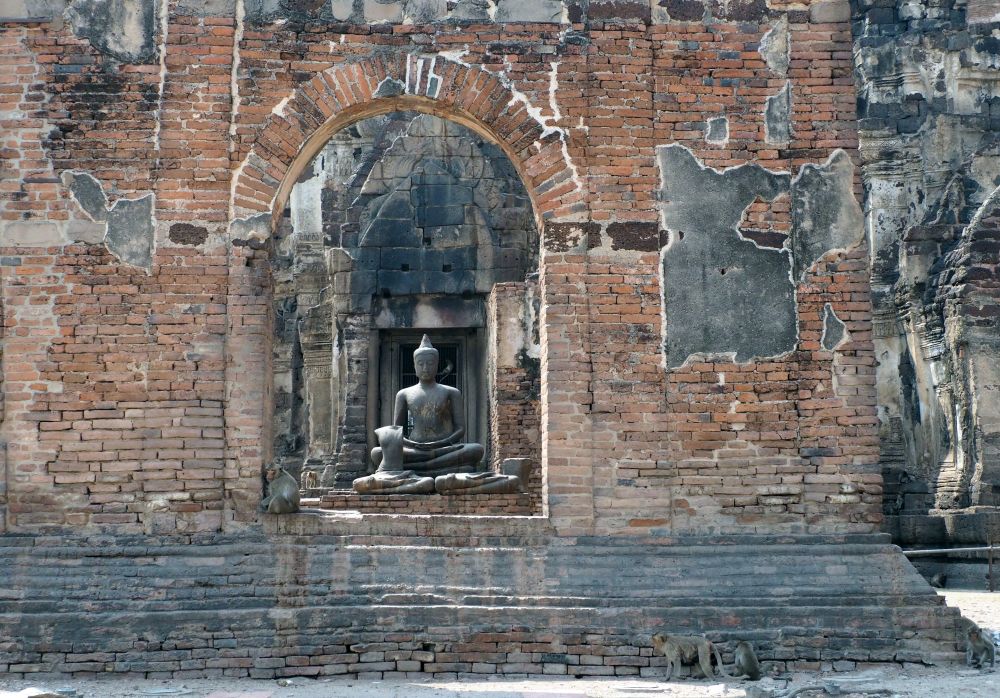
Anyway, when we visited the temple, in the middle of an extremely hot day, the monkeys stayed mostly quite still. They huddled against the sides of the temple in the shade and generally left us alone. It meant, though, that I didn’t feel like I could approach the temple very closely, and the monkeys smelled pretty terrible too.
Book your accommodations in Thailand through Expedia, Booking.com, VRBO, or Hotels.com.
Phra Narai Ratchanivet
Our next stop, also in Lopburi, was at the ruins of King Narai’s palace. He ruled the Ayutthaya kingdom from 1656 until 1688. Inside a large walled compound, what remains is mostly walls with crenellations and hulks of buildings with arched windows. Unfortunately, we weren’t allowed to get very close to the buildings at all. There was an event going on and the complex was temporarily closed. Judging by what we could see from nearby the entrance gate, we didn’t miss much.
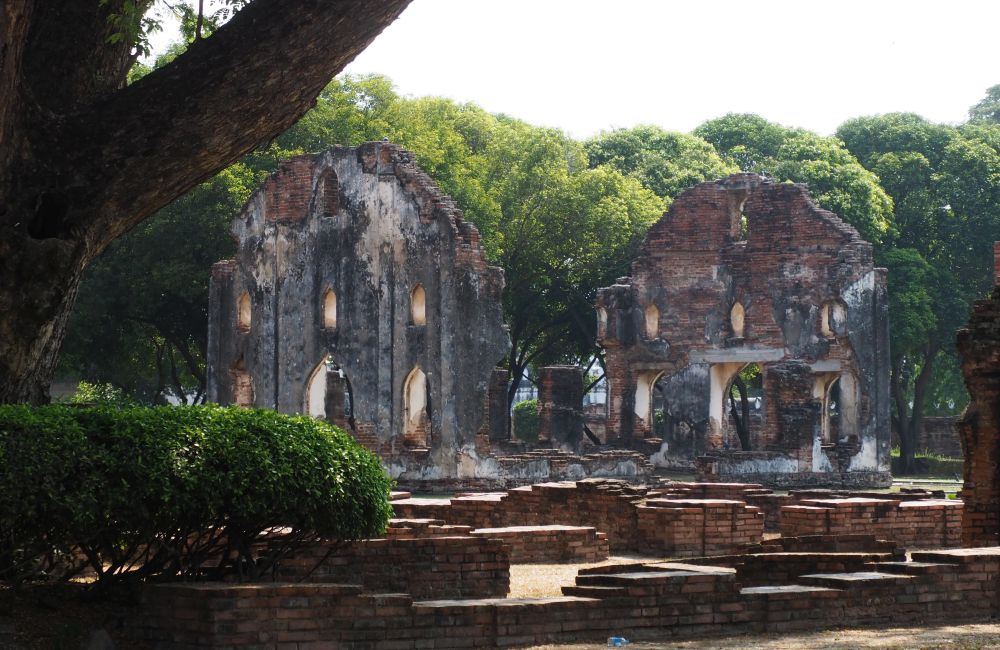
Wichayen House
Nearby in Lopburi stands Wichayen House, another historical site: the first western-style house built in the area. It dates to the 17th century, built by King Narai for visiting French envoys. Then when the French left, a Greek named Constantine Phaulkon became a minister in King Narai’s government and moved into the house.
The property holds the house Phaulkon lived in but also the remains of several other structures. The house is in a European style, as are the other buildings, which may have been reception areas. The Christian church on the site is also in a European style but with some local influences as well, like lotus shapes at the top of the columns. This is the first Christian church built in Thailand.
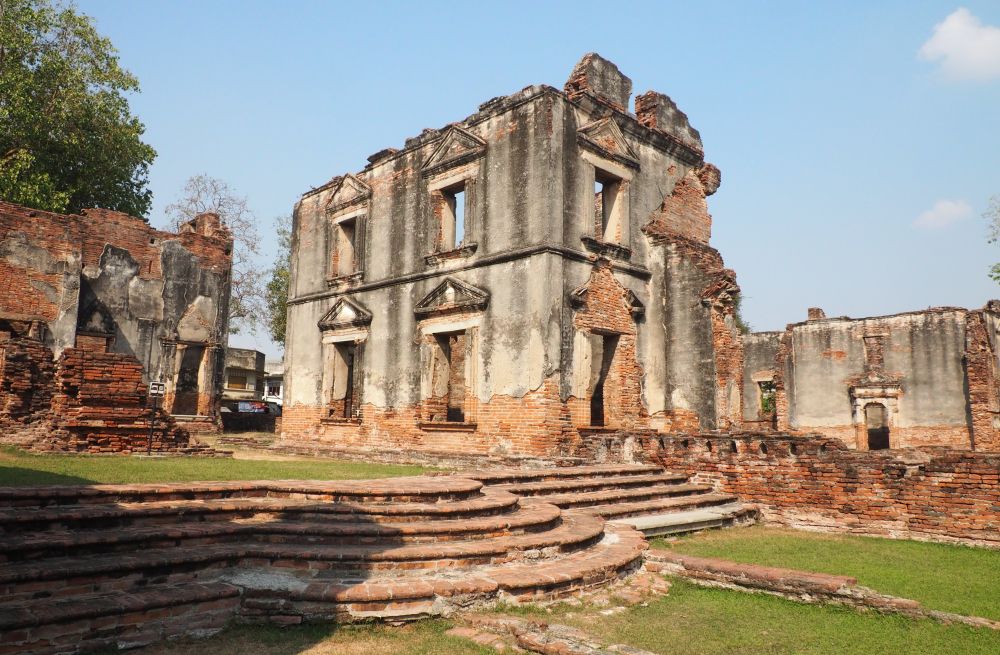
When we were done wandering the Wichayen House site, we drove on to Si Thep, another two hours away. We checked into a hotel called Ozone Resort, right next to Si Thep Historical Park. It was a rather quirky hotel, and clearly very newly opened. But never mind; I’m happy as long as the room is clean and comfortable, which it was. We all ate dinner together next door: very tasty hotpot.
Day 2
After breakfast at the same restaurant bright and early, we took the van to the nearby Si Thep World Heritage site. Si Thep was the reason I wanted to take this tour: to be able to write about it for my other website about UNESCO sites.
Si Thep – Muang Nai
This brand-new UNESCO World Heritage site in Phetchabun province is about 240 kilometers (150 miles) north of Bangkok, in central Thailand. It is made up of three component parts, all of them archaeological sites, and we visited two of them.
The first was Si Thep Historical Park on the site of the ancient town of Si Thep, sometimes called Sri Thep. The historical city had two parts: an inner town and an outer town, together covering 4.7 square kilometers (1.8 square miles). The inner city had both a moat and a wall around it. It was more or less circular with a diameter of about 1.5 kilometer (1 mile). The outer town annexed a bigger rectangular area to that circle, also with moats and walls around it. The inner town, called Muang Nai, is the historical park and part of the UNESCO site. There’s very little left of the outer town, called Muang Nok.

Muang Nai is mostly a product of the Dvaravati culture, dating to the 6th – 10th centuries AD. Today, the site of this ancient city is a park, a shady area of grass and trees. Three larger structures still stand: two temples or prangs opposite each other, and a large pyramid structure. Outside of those, there are 45 other smaller ruins, mostly just foundations, outlines of ponds and other such remnants.
Muang Nok has 54 additional ancient remains, but isn’t part of the historical park because it is now agricultural land.
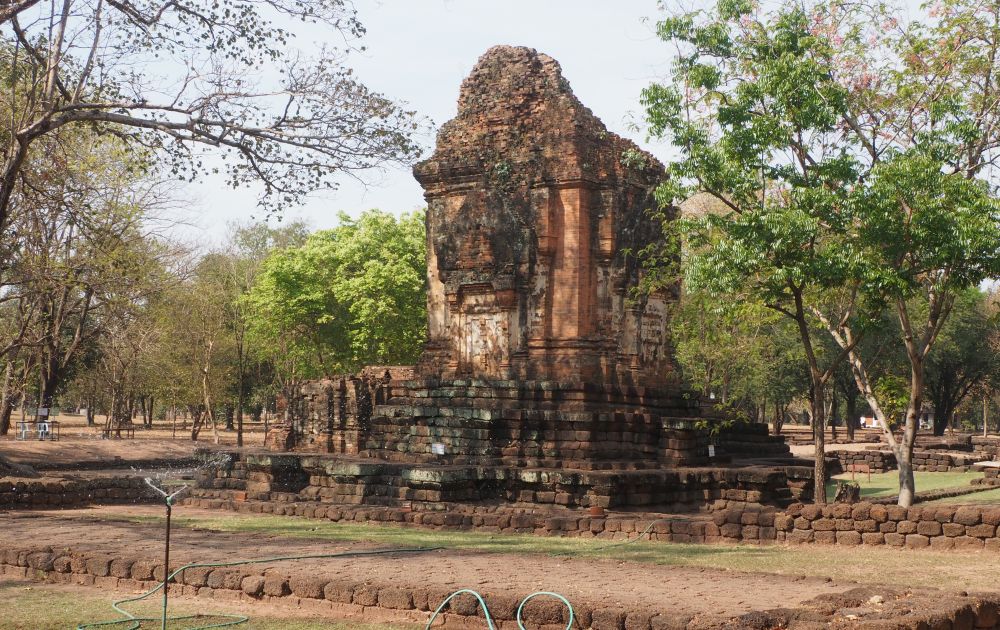
I must say that these weren’t the most impressive ruins I’ve seen. It takes quite a bit of imagination to picture what they once were. There are two prangs that face west in a line: Prang Si Thep and Prang Song Phi Nong, both of which are made of bricks on a laterite base. Both date to the 10th-11th centuries and show Khmer influence, with Hindu-style decorations. They may have replaced earlier Dvaravati structures.
More interesting was the Khao Klang Nai Monument, a rectangular pyramid made of the dark volcanic stone, laterite. Probably dating to the 6th-7th century, it’s 48 meters (157 feet) by 88 meters (289 feet) and 12 meters (39 feet) high. It would have been higher originally, probably with a temple or stupa at the top.
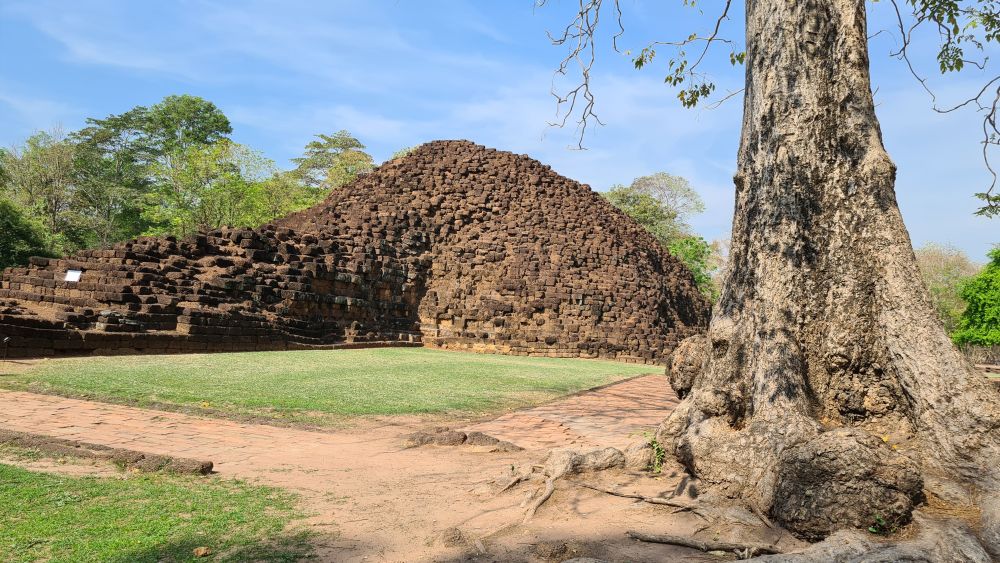
On one side of Khao Khlang Nai visitors can see remnants of stucco decorations, roofed over for protection. They depict “supporting dwarves” with animal or human heads. Picturing those sorts of details covering the whole structure made it clear to me what an impressive appearance it once had.
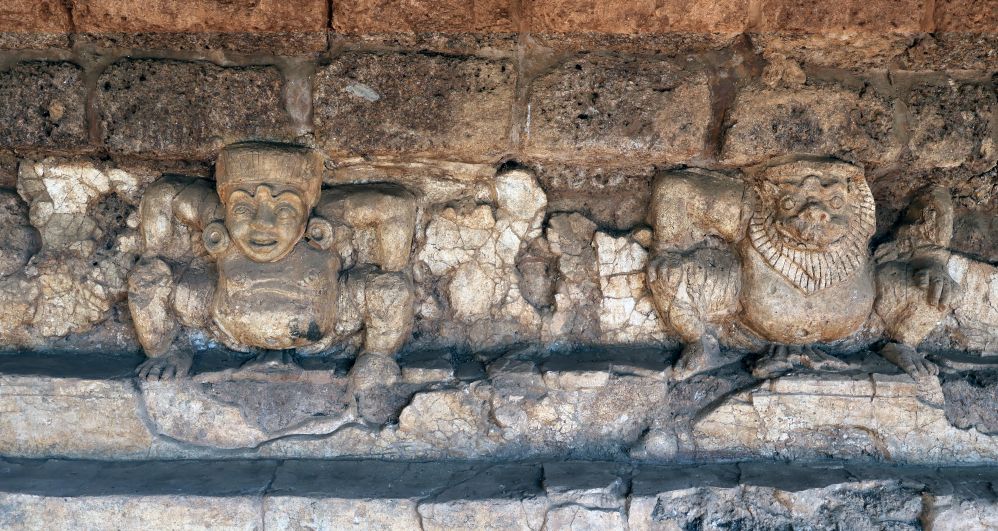
In a small modern building nearby, visitors can see some interesting archaeological finds: skeletons, which have been left in situ. The most complete is of a very tall woman, found about four meters down, wearing a necklace and a bracelet and holding an iron tool. Archaeologists date her to about 1,700 years ago. Nearby, but only one meter down, so from a different time period, is a partial elephant skeleton. It was buried deliberately with pottery containers. Signs on the wall – all in Thai, but I used Google Translate – explain that an agricultural community lived here as far back as prehistoric times.
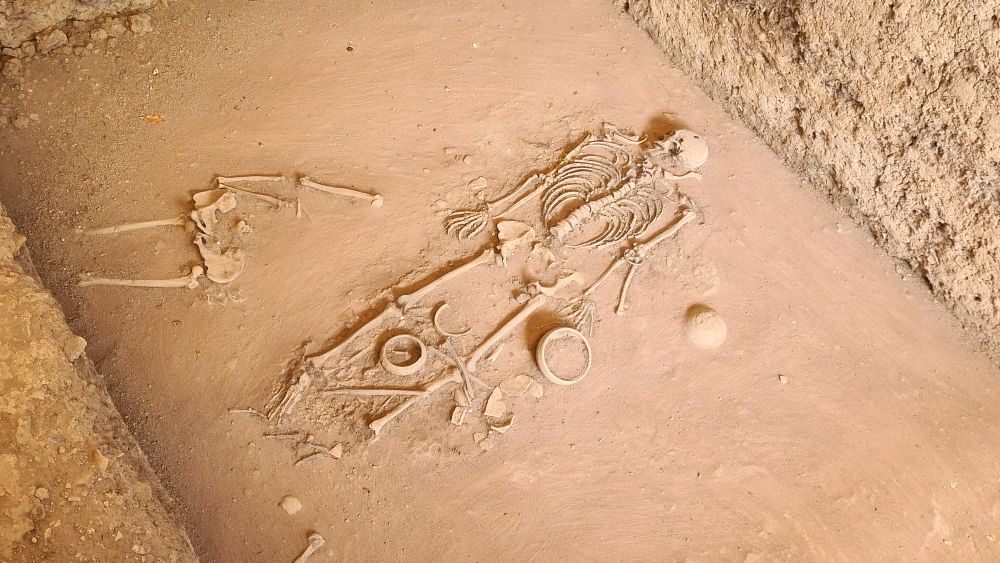
Si Thep – Khao Klang Nok Monument
About two kilometers outside Si Thep Historical Park is the massive Khao Klang Nok, once a monastery or pagoda. Like Khao Klang Nai, it was a pyramid, but this one was square and even larger, at 64 meters (210 feet) on a side and 20 meters (66 feet) high. Again, it would have been significantly higher in its day. It had a grand staircase up each of the four sides. The base is laterite and there was a brick stupa on top that has crumbled, and may have been bell-shaped or dome-shaped. It would have had smaller pagodas surrounding it. A product of the Dvaravati culture like Khao Khlang Nai pyramid, it dates to the 7th-8th century AD.
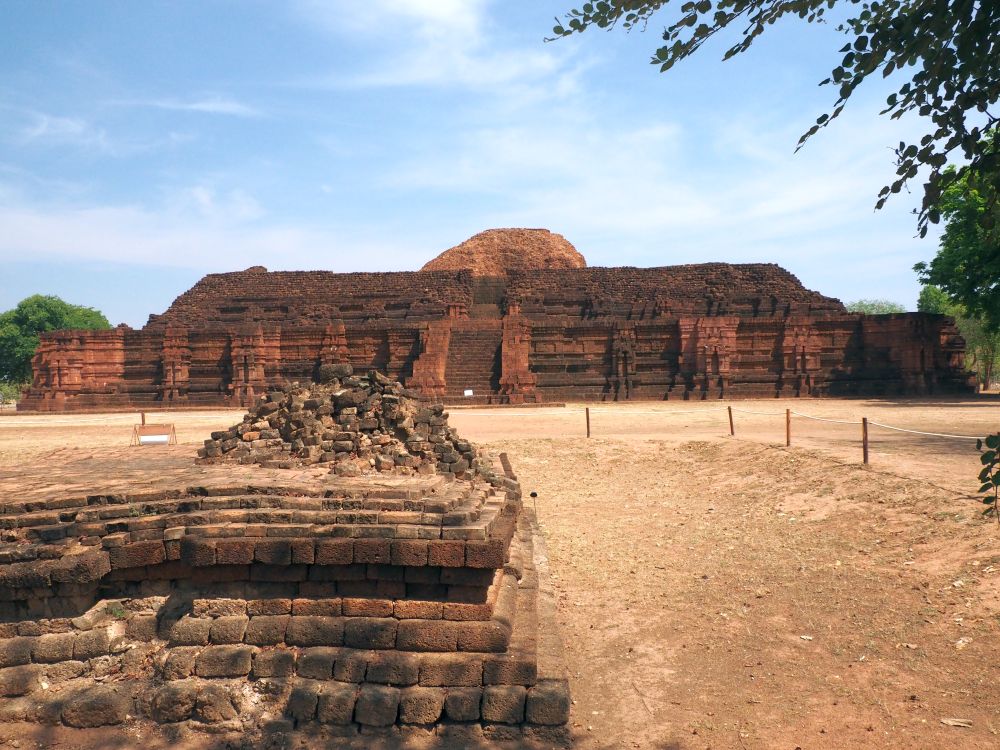
Khan Khlang Nok likely represented Mount Meru: the center of the universe in Hindu cosmology. We saw similar with some of the pyramid-shaped temples at Angkor in Cambodia.
Perhaps because there is no entrance fee (unlike at Muang Nai), this site had somewhat more visitors, though it still wasn’t very busy. A small handicrafts market is right beside the parking spaces.
Apparently there was an influx of Thai visitors to the site (as well as the historical park) right after the announcement that it had been added to the UNESCO list. So many climbed to the top that authorities feared the tourists would do damage to it, or they’d hurt themselves. Climbing is now prohibited.
Si Thep – Khao Thamorrat Cave
We didn’t see this last part of the UNESCO site. Apparently it is not set up for tourism at all. You have to hike up Khao Thamorrat mountain to get there. This is only possible with an official guide, arranged in advance. I’ve found no information online about how to do this, though. I’d suggest contacting the Si Thep park at (6656) 921-322 or the tourist information center at (6656) 921-354 to ask how to arrange a guide. Or if you travel with Thailand Journeys, see if they can arrange it for you.
The cave is at the top of the mountain. In the Dvaravati period, it served as a Mahayana Buddhist monastery and may have had a building next to it. What’s unique about it are the bas-relief sculptures carved into its walls. There are three standing Buddha images and a number of Bodhisattva images. Some of the Buddha heads have been removed and can be seen at the Bangkok National Museum and the Jim Thompson House in Bangkok.
The cave is located on the same axis as Prang Si Thep and Prang Song Phi Nong. In other words, the two prangs face west toward this mountain and this cave.
Book your accommodations in Thailand through Expedia, Booking.com, VRBO, or Hotels.com.
Return to Bangkok
Before returning to Bangkok, we made one last stop at an active temple. There, we again did a prayer ritual and then we used sticks to find out our fortunes. You shake the container with the sticks until one falls out. Read the number on the one that falls out and then take the paper corresponding to that number.
I tried twice, and both times more than one stick fell out. On the second try, not wanting to continue making a fool of myself, I just took one of them for my fortune. The paper described a terrible future, predicting all sorts of calamities, but Yoo assured me that I could return the paper and not take the bad luck with me! While I don’t believe in this ritual at all, I still found it disturbing.
Anyway, the temple was unfinished. Its bare concrete structure was open to the air, and the decorations, in a range of stages of completion, were interesting to see. An artist was busy working on a statue around a column, shaping chicken wire that would eventually carry the concrete. Another column had a finished sculpture, but as yet unpainted. Another was complete.
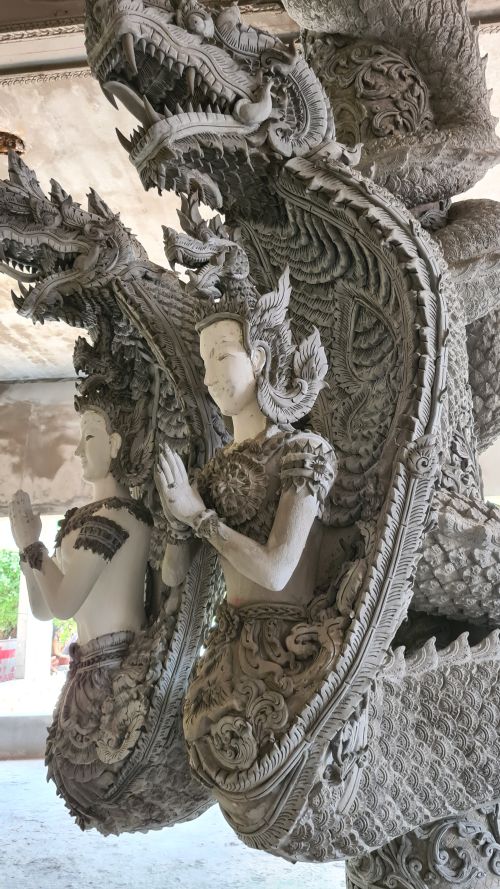
Since Si Thep is about 240 kilometers from Bangkok, it took us about three hours to get “home.”
Review of Si Thep
I asked Thailand Journeys to take me on this tour specifically because I wanted to see Si Thep. To be honest, though, Si Thep just wasn’t that impressive, especially after we’d seen several pretty spectacular ancient temples in Cambodia. On a previous trip, I’d visited both the historic town of Sukhothai as well as Ayutthaya. Both of them are more extensive and better preserved than Si Thep. Khao Klang Nok was the most impressive part of Si Thep, just based on sheer size.
The main reason Si Thep is on the UNESCO list is that it represents the Dvaravati Empire period from the 6th to the 10th centuries, when a unique style of art developed from Indian traditions – Hinduism and both Theravada and Mahayana Buddhism. It’s now simply called the Si Thep School of Art. Of that art, what has escaped looters over the centuries is now in the Bangkok National Museum, not at the national park.
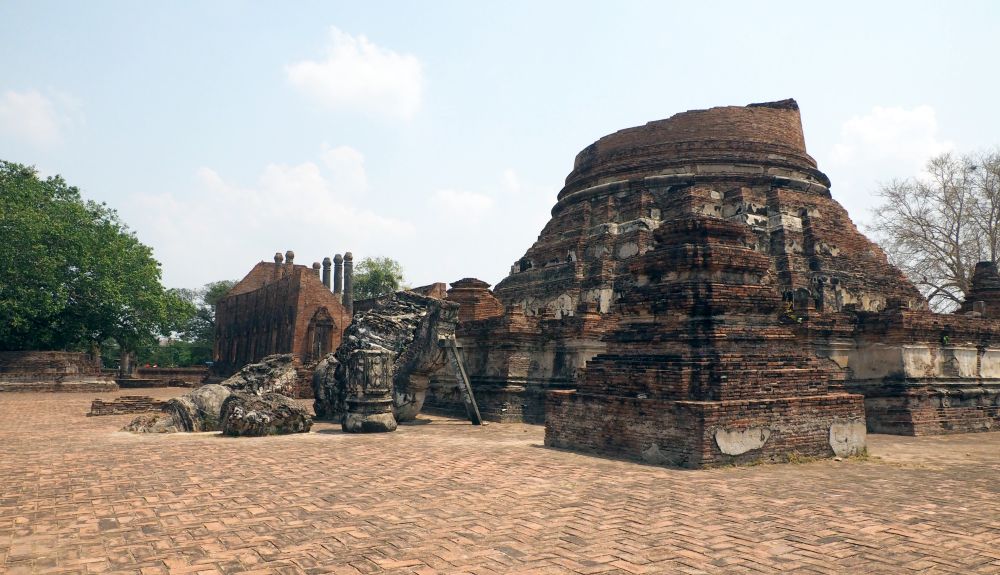
Review of Thailand Journey’s Si Thep excursion
Having said that, though, this tour was an excellent outing for people like us who had already seen the main sights in and near Bangkok. It combined a number of lesser-known sights that were all interesting and untouristed. And it allowed us to see a part of Thailand that is completely outside the tourist eye. I never felt rushed, as I often do when I take group tours. The staff of Thailand Journeys were all friendly and cheerful and helpful, willing to answer every question I had.
My favorite parts of the tour were the boat trip around Ayutthaya, which allowed us to see Ayutthaya from an entirely different angle, and Wat Kudi Dao.
I asked Yoo, now that he’d done a trial run of the tour, what he might change about it for paying guests. His answer was nothing, except that he’ll have a properly-trained guide who will know much more about the places the tour visits.
I’ve marked all the places in the itinerary above (except the last temple near Si Thep – I didn’t get its name) on the map below.
So, in other words, I recommend this tour particularly for people who have seen the main sights of Bangkok already, or who really like smaller, less well-known places, but don’t want the added stress of driving themselves. And, of course, UNESCO site geeks like me who just want to see Si Thep. It’s only two days and one night, and includes plenty of different things to see, good food and comfortable lodgings.
Thailand Journeys, besides being one of very few companies offering tours from Bangkok to Si Thep, impressed me on both the tours I took with them. They are efficient and professional every step of the way. Since they offer private tours as well as group tours, they can adjust an itinerary to suit your requests. Most of their offerings are in Thailand, but they also offer tours that include Vietnam, Cambodia and/or Laos.
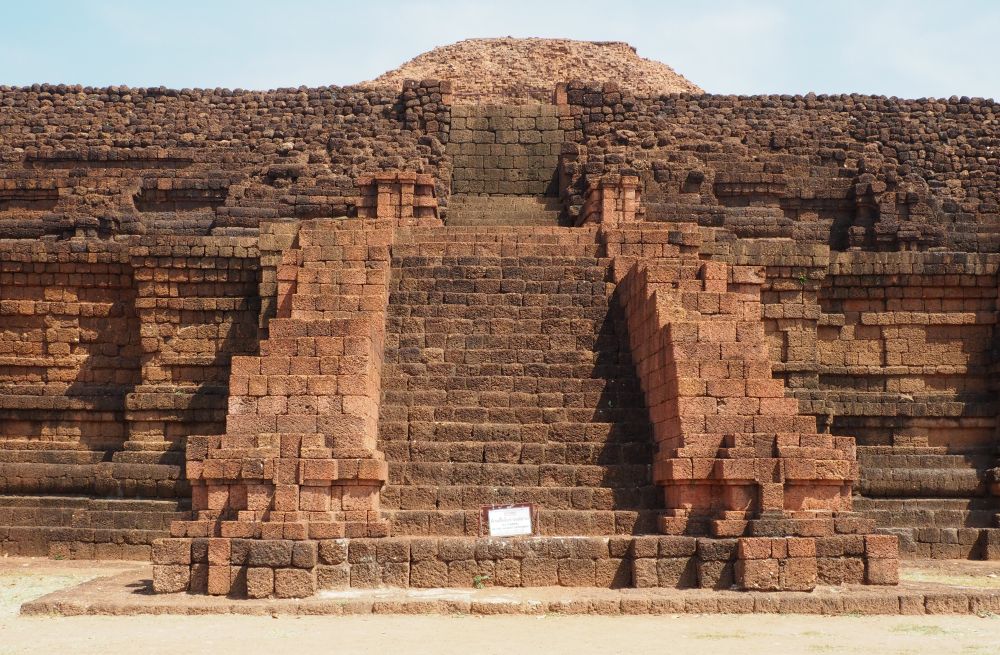
Other ways to see Si Thep
If you’re considering trying to see these sites on your own, you could certainly do so. Rent a car right from the airport and drive north. In that case, you could include these sites, but then continue further into far northeastern Thailand to see Ban Chiang Archaeological Site. Or you could turn northwest and see Sukhothai. Either option would mean a lot of driving. While the roads are good, I’d make sure to plan it over several more days if you’re unfamiliar with driving in Thailand. Taking a tour like this one with Thailand Journeys is probably more efficient and definitely easier.
My travel recommendations
Planning travel
- Skyscanner is where I always start my flight searches.
- Booking.com is the company I use most for finding accommodations. If you prefer, Expedia offers more or less the same.
- Discover Cars offers an easy way to compare prices from all of the major car-rental companies in one place.
- Use Viator or GetYourGuide to find walking tours, day tours, airport pickups, city cards, tickets and whatever else you need at your destination.
- Bookmundi is great when you’re looking for a longer tour of a few days to a few weeks, private or with a group, pretty much anywhere in the world. Lots of different tour companies list their tours here, so you can comparison shop.
- GetTransfer is the place to book your airport-to-hotel transfers (and vice-versa). It’s so reassuring to have this all set up and paid for ahead of time, rather than having to make decisions after a long, tiring flight!
- Buy a GoCity Pass when you’re planning to do a lot of sightseeing on a city trip. It can save you a lot on admissions to museums and other attractions in big cities like New York and Amsterdam.
- Ferryhopper is a convenient way to book ferries ahead of time. They cover ferry bookings in 33 different countries at last count.
Other travel-related items
- It’s really awkward to have to rely on WIFI when you travel overseas. I’ve tried several e-sim cards, and GigSky’s e-sim was the one that was easiest to activate and use. You buy it through their app and activate it when you need it. Use the code RACHEL10 to get a 10% discount!
- Another option I just recently tried for the first time is a portable wifi modem by WifiCandy. It supports up to 8 devices and you just carry it along in your pocket or bag! If you’re traveling with a family or group, it might end up cheaper to use than an e-sim. Use the code RACHELSRUMINATIONS for a 10% discount.
- I’m a fan of SCOTTeVEST’s jackets and vests because when I wear one, I don’t have to carry a handbag. I feel like all my stuff is safer when I travel because it’s in inside pockets close to my body.
- I use ExpressVPN on my phone and laptop when I travel. It keeps me safe from hackers when I use public or hotel wifi.


